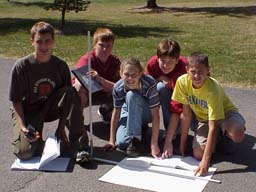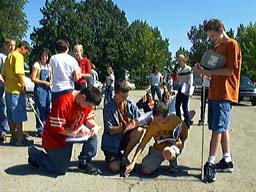
NOON SHADOWS ON THE EQUINOX 2002
Teacher Background
As the Earth progresses in its yearly orbit around the Sun, shadows cast by the Sun vary in length due to the tilt of the Earth's axis (23.5 degrees.) Most students are aware that shadows at midday are longer in the winter and shorter in the summer. What they may not understand is the relationship between their latitude and the length of shadows. This is particularly significant on the spring and fall equinox when the Sun's position in the sky is directly above the equator. In this activity students will determine the angle of the shadow cast by the midday Sun on the equinox and compare it to their latitude.
WARN YOUR STUDENTS TO NEVER STARE DIRECTLY AT THE SUN. PERMANENT EYE DAMAGE CAN OCCUR.
Objectives
Students will measure the length of the shadow cast by a meter stick at midday on the spring and/or fall equinox. They will discover that the angle of the Sun's shadow approximates their geographic location in degrees north or south latitude.
Materials
2 meter sticks
level to ensure the meter stick is vertical
data sheet or log book to record measurements and times
watch
Engage
Ask students to explain the reason for the changing length of the Sun's midday shadow. What is the apparent position of the Sun on the equinox? At what time would the shadow be shortest? (Hint: solar noon is mid-way between sunrise and sunset which, throughout the year, may not be exactly local noon by the clock) Have students suggest ways in which the angle of this shadow could be measured. Students should predict the angle of the midday shadow on the equinox. Remember, they will be determining the angle of the shadow, not the angle of the Sun above the horizon.
Explain/Explore
The 2002 fall ( autumnal ) equinox occurs at 12:55 a.m. EDT on Monday, September 23rd, when the Sun crosses the equator on its way south for the coming northern hemisphere winter and the southern hemisphere summer. The activity should be conducted as close to that day as possible. If your local skies are too cloudy on Monday, September 23rd, conducting the activity with students on Tuesday, September 24th should still yield fairly good results.
Design a device to support a meter stick in a vertical position. Inexpensive shelf brackets can be purchased from a local hardware or discount store and fastened to one end of the each meter stick. A student can then place his/her foot on the bracket resting on the surface, thereby supporting the meter stick in a vertical position. Use a level to ensure that it is exactly vertical. If it's not too windy, lay a piece of paper on the ground on which the shadow of the meter stick can be displayed. Teams of students should use a second meter stick to measure the length of the shadow. Record the time and shadow length.

Since Illinois will still be following daylight savings time, solar noon will occur between 12:30 pm and 1:30 pm CDT. Determine the time of solar noon for your location. Measurements should be taken at 5 minute intervals for one hour starting 30 minutes before local solar noon.
Calculate solar noon for your location
Select the measurement with the shortest shadow length. Either refer to a tangent table or use a scientific calculator and the following formula to determine the angle between the tip of the shadow and the base of the vertical meter stick: length of shadow divided by 100 = (2nd or inverse function) tangent. (Or you can challenge students to come up with the appropriate formula, depending on their mathematical capabilities.) Make sure that your shadow length is in centimeters.

Have students use maps or an atlas to find their exact latitude. How does the calculated angle of the shadow compare with their latitude? What would be the angle of the Sun's midday shadow on the equinox at the equator?
Teacher note: For those wanting to involve all of their classes in this project, shadow measurements can be taken at five minute intervals throughout the day. Mount several meter sticks on a classroom wall, one representing the vertical meter stick casting the shadow, and the others measuring horizontally out from its base. Connect various colored pieces of yarn from the top of the vertical meter stick to the shortest shadow measurement for each class period along the horizontal meter sticks. The resulting display will prove to be a colorful eye catcher which will clearly show the results from each class and make a great tool for comparison of data.
Expand/Adapt/Connect
Is the Sun always at its highest point in the sky at local noon (by the clock)? Advanced students can research the exact times this occurs at various locations within their time zone. This activity can be repeated up to the winter solstice (the Sun's furthest position south of the equator.)
